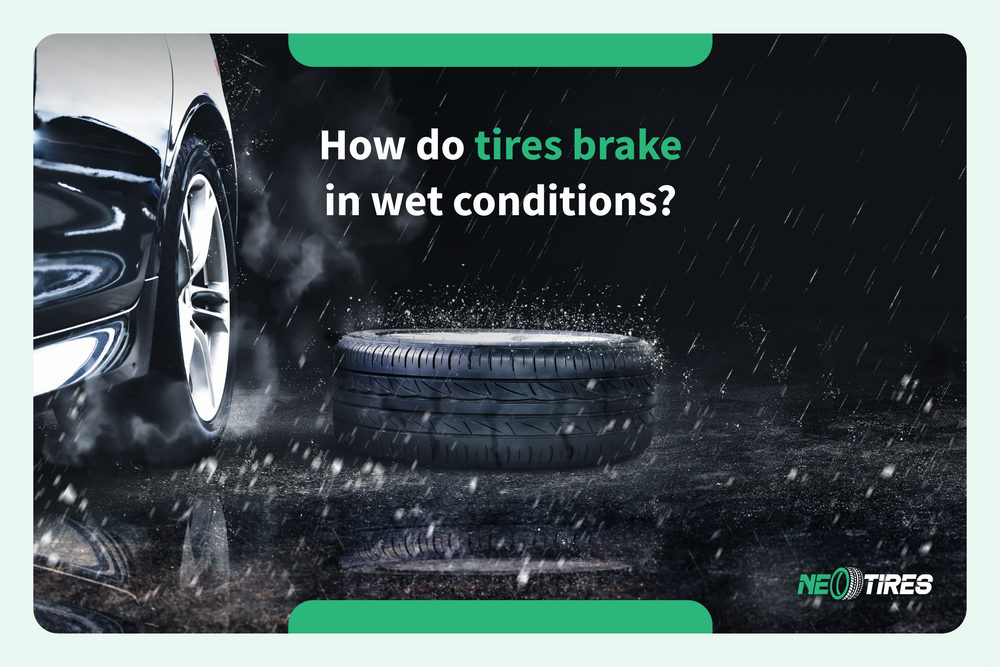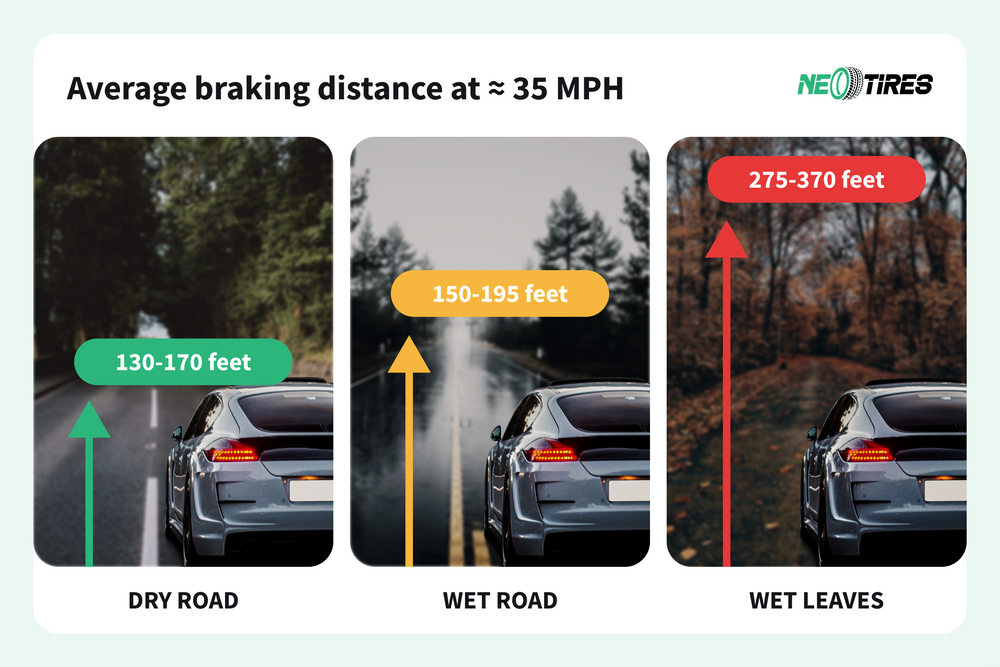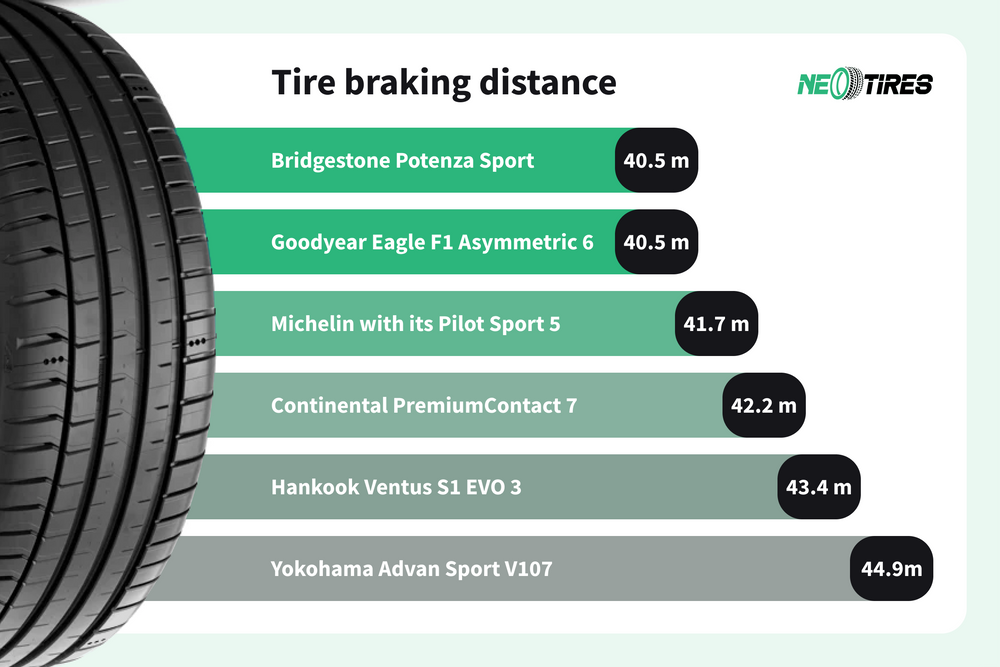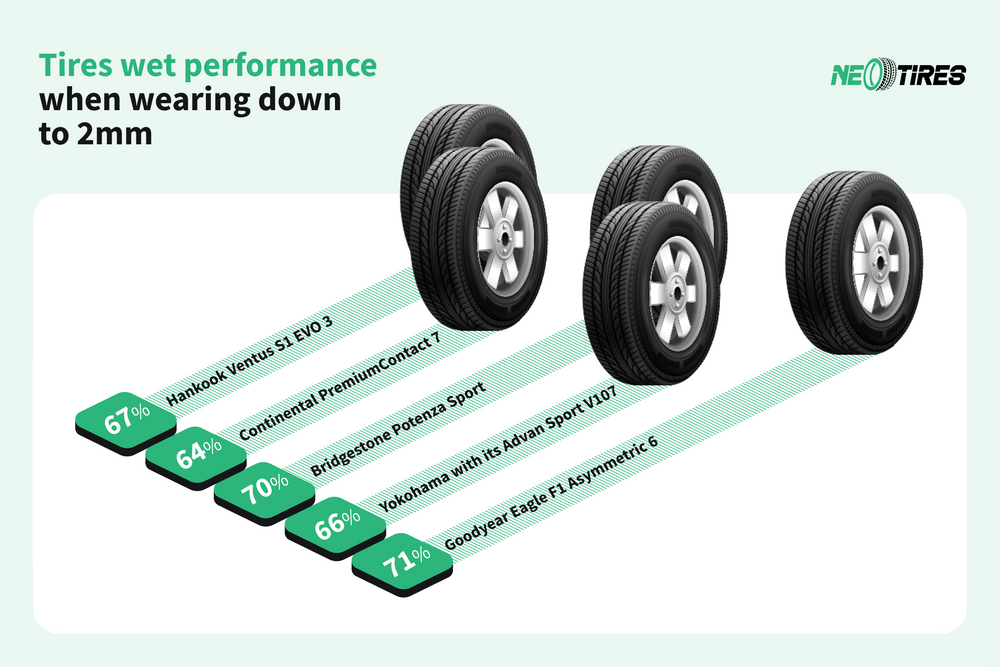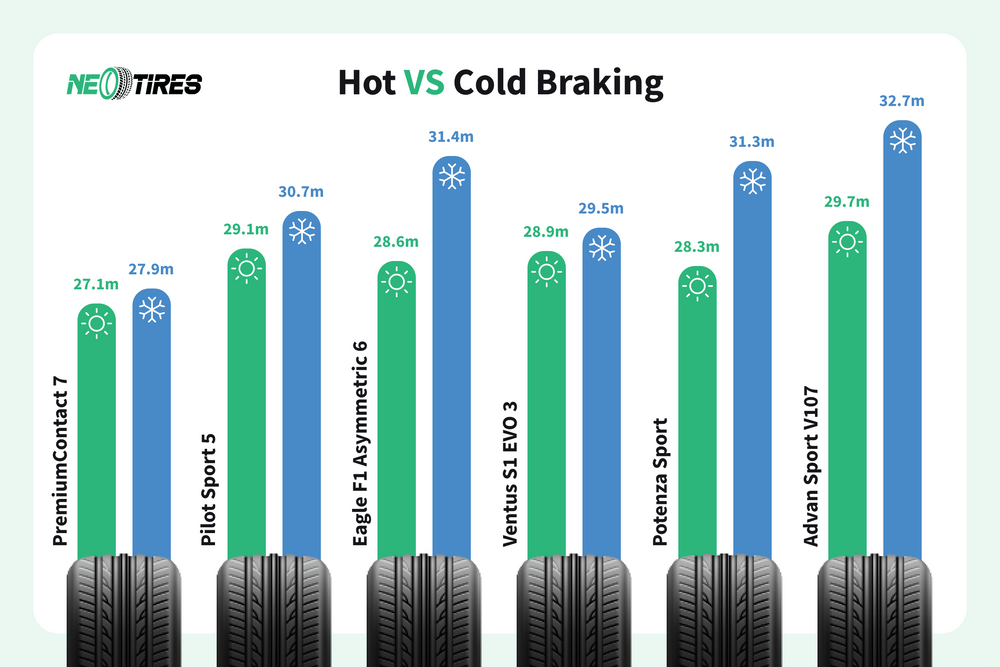The tire industry is constantly evolving and tire makers are pushing the boundaries to bring their performance to new levels. Nowadays, manufacturers focus not only on a single aspect of performance but also on fitting as many as possible in one place to radically change the concept of performance tires. Longevity is combined with low rolling resistance, and at the same time, dry braking abilities are combined with wet braking.
If you recall, Michelin was the first to declare that tire performance can last forever. "Tire performance over a lifetime" - that's exactly the concept that the tire maker insistently promoted some time ago. And it was right because today's tires blend an amalgam of performances that deliver impressively long-lasting endurance from all perspectives.
With this positive introductory note, I would like to talk today about the wet braking abilities of the tires. In my opinion, this aspect is crucial for the safety of the car and the driver. Many car owners disregard this aspect when buying new tires. But this is a dramatic mistake. Tire braking tends to increase when the pavement is wet. As such, the risks of collision are major and the prevention of impacts becomes minor.
If you are curious to know which tire makers perform the best in terms of wet braking, you have landed in the right article. Today we will talk about different tire makers and their performances in wet braking.
Who Are Today's Heroes?
In this article, I will present 6 tire makers that have been subjected to various tests in wet braking. It is curious that, unlike other tests, these include different temperature and tire tread conditions. Some independent organizations have performed wet braking tests at high and low temperatures. Also, they tested the tires in new condition and with a treadwear of 2 mm. All these conditions showed the different behavior of the tires in wet circumstances.
In the same context, the 6 members in today's competition are the following models:
It seems that the competition was fierce as all 6 models come from reputable tire makers with an excellent reputation. All tires that participated in the test are 225/40 R18 size. For more objective testing, they were mounted on the same vehicle model, namely the sporty Volkswagen Golf GTI guy. Let's see what the wet braking tests show.
Wet Braking With 2 mm Worn-Out Tires
Tires in new condition deliver a decent performance rating. But their new condition is not permanent. As such, it is probably more interesting to know how they behave after some time when the tread already starts to wear. To answer this question, the 6 heroes in today's article were artificially subjected to wear of up to 2mm. This helped to evaluate wet braking performance in a much more realistic scenario. In such conditions, the tires braked on wet surfaces as follows:
The Bridgestone Potenza Sport and The Goodyear Eagle F1 Asymmetric 6 were absolute leaders, providing both the same wet braking distance: 40.5m.
Next in the ranking was Michelin with its Pilot Sport 5 model. The braking distance reached 41.7m.
Further on, Continental followed with its PremiumContact 7 model, which braked completely over a distance of 42.2m.
Among those who remained behind, the Hankook Ventus S1 EVO 3 performed better braking at 43.4m. Respectively, Yokohama Advan Sport V107 recorded the weakest result with a distance of 44.9m.
As you can see, the shorter the braking distance, the safer the tires are on wet roads. According to the test results, Bridgestone and Goodyear scored the best results with their worn tires at 2 mm.
Curiously, Michelin ranked 2nd. While its results are not bad at all, this tire maker was the absolute leader in terms of wet braking some time ago. This speaks to the fluctuating dynamics of the industry and the fact that competitors never rest.
What Is The Ratio Between New vs. Worn Tires?
Tire performance changes over time. This is a natural phenomenon resulting from their daily usability. The question is How much performance downgrades over time? Thanks to the tests we managed to do, we can answer this question easily and quickly.
Before presenting the results, I want to note how important it is for a tire to maintain its performance over time. This is what distinguishes a high-quality tire from a mediocre one. Ideally, performance should be consistent. But as this is not realistic, it would be good for them, at least not to downgrade considerably.
This time, I will talk in percentages rather than meters. The following percentages refer to the extent to which each model was able to keep its new-state wet braking performance when worn to 2mm.
The one that stood out the most was the Goodyear Eagle F1 Asymmetric 6. It kept about 71% of its initial performance in its worn condition. Further on, Bridgestone provided a pretty close result, keeping 70% of its initial wet performance while braking.
Hankook Ventus S1 EVO 3 ranked 3rd, preserving about 67% of the initial wet braking properties. It was succeeded by Yokohama with its Advan Sport V107 model. As such, these tires showed a retention of 66% of their original wet-stopping performance.
Finally, Continental PremiumContact 7 showed an unexpected result with only 64% retention of the initial wet braking abilities when worn at 2mm.
If we look macroscopically at this ranking, we notice that the difference between the first and the last competitor is not that great. We are talking here about a difference of only 7 percent, which speaks of an overall high standard of wet quality of these tire makers. Certainly, they will not stop optimizing the technologies of their tires. In this sense, it is very intriguing to see how these statistical data will fluctuate shortly.
What About Cold And Warm Wet Braking (18/8°C)?
Weather conditions greatly influence the behavior of tires. Here I mainly refer to temperature fluctuations. As such, temperature can increase or decrease the tire pressure, for example. Also, they can change their performance depending on the effect of temperature on the tire components.
Depending on the composition of the tire, the material is prone to getting stiffer. As a result of the stiffness, the tire loses microscopic contact with the road surface. Consequently, road grip becomes weaker, which translates into poorer traction including worse braking abilities.
With these premises in mind, we cannot deny the influence of temperatures on the braking properties of tires. While we expected that in cold weather the performance would decrease, we were curious to know by how much. As we foresaw, braking distances in wet cold conditions were longer. This proved once again that summer tires are not recommended for low temperatures, as their braking distance becomes extremely unsafe.
How Tires Behave In Cold/Hot Wet Braking Conditions:
Continental PremiumContact 7 provided pretty decent wet stopping in warm conditions. It delivered 27.1 m. But once the temperature dropped to 8°C, it recorded a distance of 27.9 m. That is less than one meter.
On the other hand, Michelin's fluctuations generated a lot of confusion. While the wet braking in normal conditions was 29.1m, it stopped definitively after only 30.7m in cold conditions. That means the distance has increased by more than a meter.
Further on, the statistics get a little worse. Goodyear scored 28.6m under normal conditions. But with the cooling of the temperature, they provided 31.4 m, which means almost 3 meters more.
Next on the list are Hankook Ventus S1 EVO 3 tires which displayed a stopping distance of 28.9m, almost like Goodyear. But unlike the latter, Hankook provided only 29.5 m in cold conditions, which is less than a meter.
In the same context, Bridgestone stood out with a relatively small difference between wet braking in hot and cold temperatures. It is about 28.3 m vs. 31.5.
As for the Yokohama Advan Sport V107, it extended its braking distance from 29.7 m to 32.3 m with the cooling of temperatures to 8°C.
According To This Data...
Hankook and Continental are the most versatile in temperature fluctuations. These marked the smallest decreases in wet braking performance. On the other extreme, Goodyear Eagle F1 Asymmetric 6 and Bridgestone with its Potenza Sport model leave a lot to be desired. These delivered a severe decline in braking abilities with the change in weather conditions.
Probably the leaders of this test, Continental and Hankook, use a special recipe in the composition of their tires. The specific ingredients are responsible for better resistance to temperature changes.
Either way, temperature sensitivity is a normal phenomenon for the tire industry. There is no ideal and universal tire. The conclusion you have to make is that it is crucial to choose your tires according to the conditions in which you predominantly drive.
Bottom Line
Here we go with everything you need to know about these leading manufacturers from their wet braking perspective. I do not exclude that soon, the performance ratings will change. This is because these manufacturers also know their pluses and minuses. And I bet that they are already working on optimizing the shortcomings.
Let's take the example of Michelin. It prided itself for a long time as the absolute leader in wet braking. But this did not last forever. Michelin's amazing performance angered its competitors. As such, Goodyear and Bridgestone did not take long to overcome certain aspects of Michelin's wet braking performance.
The beautiful part is that this perpetual competition generates optimizations, improvements, and new ambitions. As such, it is a healthy competition from which everyone can only win.
Also, let's not forget that certain natural factors mercilessly impact the behavior of tires in wet braking. However, leading tire manufacturers are also aware of this impact. And I'm sure they are not sitting idly by.
I hope this article made you look at the wet braking properties of tires from a different perspective. The most important aspect of it is that the dynamics of the tire industry are always shifting, challenging tire manufacturers for more. Consequently, the tire industry is not at all static, generating the creation of new performance standards that we don't even imagine as being realistic yet.
Braking On Wet Roads: FAQs
Why Should You Avoid Heavy Braking On Wet Roads?
Water during rains forms a barrier that affects the tire's ability to brake. The braking distance is likely to increase significantly in such conditions. It is advisable to reduce speed during rain and brake judiciously. This will allow the tire to eject water from its channels more efficiently and reduce hydroplaning risk. Ideally, opting for tires specially oriented to wet weather would be good. Their tread is well thought out so that the evacuation of water takes place very quickly, ensuring traction and solid grip.
What Will Happen To The Braking Distance If The Road Is Wet?
In most cases, tires brake more quickly in dry conditions than in wet conditions. The braking distance on a wet surface increases up to 2-3 times longer than on a dry. This means that the risks of a collision or loss of control increase substantially. Drivers are encouraged to be very cautious in wet conditions, especially in braking maneuvers. In addition, opting for tires with directional patterns will help better control the wet weather conditions. This type of pattern makes water evacuation more efficient, reducing the risks of hydroplaning.
How Does Rain Affect Braking?
Moisture and water make tires slippery. Thus, the tires lose grip on the road during rain for the simple reason that they do not adhere to the road as well as in dry conditions. Precisely for this reason, it is advisable to choose tires oriented towards wet conditions, especially if you live in rainy areas. Tires such as Potenza Sport, Premium Contact 7, and Goodyear Eagle F1 Asymmetric 5, among others, are specially constructed in such a way as to ensure effective grip even in wet conditions. Their special formula "sticks" to the wet road, reducing the risks of hydroplaning. In addition, their special pattern ejects water effectively, ensuring nice and smooth traction.
Is Stopping Distance The Same On A Wet Road And A Dry Road?
No, the braking distance is not equal in wet and dry conditions. Conversely, wet conditions are likely to double the tire braking distance. To reach the same braking distance as on dry land in wet conditions, the speed must necessarily be reduced by at least 1/3. This means that if you drive at 65 mph in dry conditions, you will have to drop to about 43 mph in wet conditions to have the same stopping distance. However, keep in mind that braking on the wet is also influenced by the type and tread of the tire.
What Type Of Tires Are Best For Wet Roads?
There are various types of tire treads and each of them has a specific purpose. If we talk about rainy conditions, treads with circumferential grooves are the most suitable. These deep grooves ensure the efficient evacuation of water from the tire, ensuring stable traction and minimizing the risk of hydroplaning.
Are Wider Tires Better On Wet Roads?
According to tests, wider tires do ensure better stability in rainy conditions. This is explained by their wider contact patch with the wet road. The more rubber on the wet surface, the more stable the tire is in the respective conditions. Also, it's worth mentioning that the tread pattern of the tire plays a no less important role in nailing it on wet surfaces. Consider tires with deep circumferential grooves especially if you live in rainy areas.
Why Trust Us?
NeoTires is a team whose goal is to improve the driving experience of every motorist. We know how important the role of tires is in various conditions. They are responsible for firm traction, reliable grip, stability in the most challenging conditions, as well as driver safety. However, if the tires are not chosen correctly, drivers are likely to experience the exact opposite of these benefits.
In this context, NeoTires is here to provide the best products in the industry at affordable prices. We want every driver to be able to choose the most suitable product in affordable conditions. For this, we have partnered up with the most reliable tire makers in the industry such as Hankook, Bridgestone, Pirelli, Continental, Nokian, Firestone, and many other reputable industry players.
In addition, we have a team of professionals who can guide you in any concern related to tires. You can count on us when you don't know which product suits you better or when you need technical and maintenance recommendations. We love our job and are happy to contribute to improving your driving experience.
With us, you can find a wide variety of products for any vehicle and any road condition. In the same way, you will find qualified assistants ready to assist you in any question. Take advantage of our special prices as well as perks like hot deals, free shipping, and installment payments, to enjoy premium products for your driving safety. Drive safe and choose your tires wisely!




